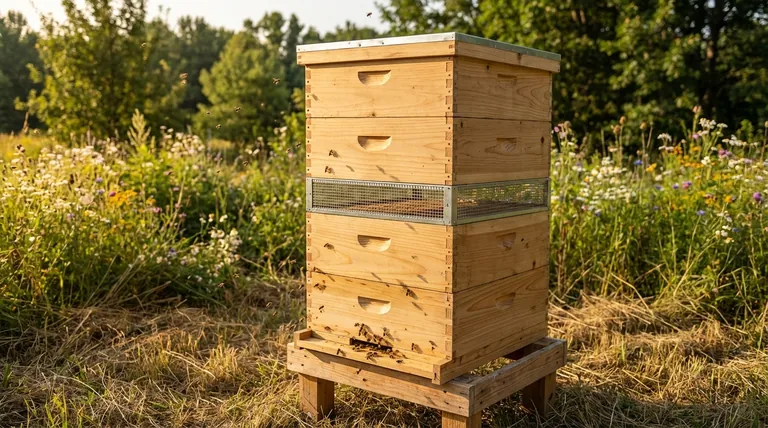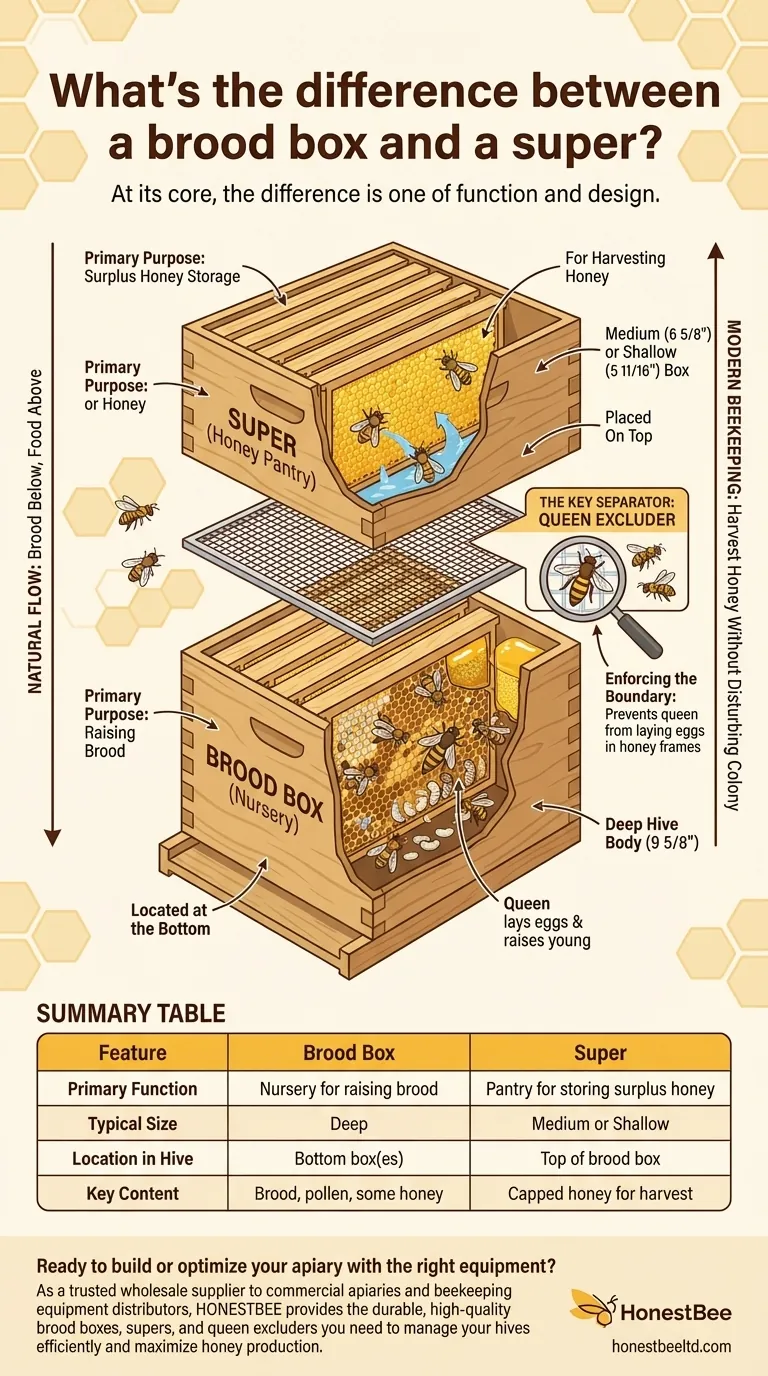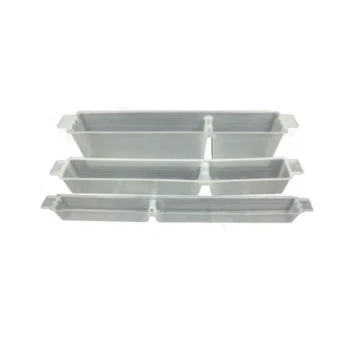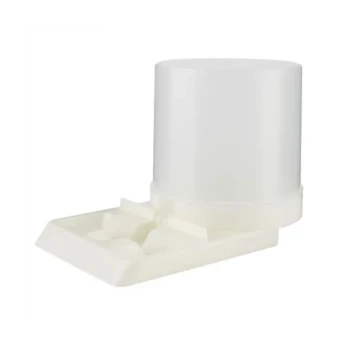At its core, the difference is one of function and design. The brood box is the nursery and living quarters of the hive, where the queen lays eggs and raises young bees. The super is the pantry, a separate box placed on top specifically for storing the surplus honey that you can harvest.
The distinction between a brood box and a super mirrors the natural way bees organize their hive—brood below, food above. This separation is the foundation of modern beekeeping, allowing you to harvest honey without disturbing the colony's vital nursery.

The Brood Box: The Heart of the Colony
The brood box, or hive body, is the engine of the bee colony. Its primary role is to provide a protected space for the colony to reproduce and overwinter.
Primary Purpose: Raising Brood
This is where the queen does her most important work: laying eggs. The frames within this box will be filled with brood in all its stages—eggs, larvae, and capped pupae.
Typical Size and Location
Brood boxes are typically "deep" hive bodies, offering the maximum amount of space for the queen's laying pattern. They form the bottom one or two boxes of the hive stack.
What's Inside a Brood Frame?
A healthy brood frame contains a pattern of developing bees. It also holds stores of pollen and honey, often arranged in an arch above the brood area, to feed the young.
The Super: The Honey Pantry
"Super" is short for "superstructure," meaning it is placed "over" or "above" the main hive body. Its sole purpose is to hold surplus honey.
Primary Purpose: Surplus Honey Storage
Worker bees will fill the super with nectar, dehydrate it into honey, and cap it with wax. Because this is above and beyond what the colony needs for its immediate survival, it's the honey the beekeeper can safely harvest.
Typical Size and Location
Supers are typically "medium" or "shallow" boxes. They are always placed on top of the brood box(es).
Why Are Supers Smaller?
This is a practical design choice based on weight. Honey is incredibly dense and heavy. A full medium super can weigh 40-50 pounds, while a full deep super could exceed 80 pounds, making it extremely difficult and unsafe to lift.
Understanding the Key Separator: The Queen Excluder
To maintain the strict division between the brood nest and the honey pantry, beekeepers often use a critical piece of equipment.
The Role of an Excluder
A queen excluder is a flat grid of wire or plastic with openings that are large enough for worker bees to pass through but too small for the larger queen.
Enforcing the Boundary
By placing an excluder between the top brood box and the bottom honey super, you prevent the queen from moving up and laying eggs in your honey frames. This ensures the supers contain only clean honey, which simplifies harvesting immensely.
How to Structure Your Hive
Your hive setup directly impacts both colony health and your own beekeeping experience.
- If your primary focus is maximizing honey harvest: Use medium supers for honey, as their lighter weight makes inspection and extraction significantly easier.
- If your primary focus is a robust colony: Use one or two deep brood boxes to give the queen ample, uninterrupted space to lay, fostering a large and healthy population.
- If your primary focus is minimizing heavy lifting: Consider a uniform hive of all medium boxes for both brood and honey, ensuring no single piece of equipment is ever excessively heavy.
Understanding this fundamental division between brood and honey is the first step toward managing your hive with confidence.
Summary Table:
| Feature | Brood Box | Super |
|---|---|---|
| Primary Function | Nursery for raising brood (eggs, larvae) | Pantry for storing surplus honey |
| Typical Size | Deep (9 5/8") | Medium (6 5/8") or Shallow (5 11/16") |
| Location in Hive | Bottom box(es) | Placed on top of the brood box |
| Key Content | Brood, pollen, and some honey | Capped honey for harvest |
Ready to build or optimize your apiary with the right equipment?
As a trusted wholesale supplier to commercial apiaries and beekeeping equipment distributors, HONESTBEE provides the durable, high-quality brood boxes, supers, and queen excluders you need to manage your hives efficiently and maximize honey production.
Contact our expert team today to discuss your wholesale needs and discover how our beekeeping supplies can support your operation's growth and success.
Visual Guide

Related Products
- Langstroth Honey Bee Box Hive Boxes for Different Depths
- Australian Langstroth Beehive Boxes for Beekeeping Wholesales
- In-Hive Dual Compartment Frame Bee Feeder for Targeted Colony Nutrition
- HONESTBEE Entrance Bee Feeder Professional Hive Nutrition Solution for Beekeeping
- Portable Bee Mating Hive Boxes Mini Mating Nucs 8 Frames for Queen Rearing
People Also Ask
- How is checking honey supers in a Langstroth hive different from inspecting Honey Flow supers? A Guide to Disruptive vs. Non-Invasive Methods
- What is the best time to inspect a hive? Optimize for Bee and Beekeeper Safety
- What factors should beekeepers consider when choosing between wooden and polystyrene hives? Maximize Bee Health and Honey Production
- What are the sizes available for Langstroth boxes? A Guide to 8-Frame vs. 10-Frame & Depths
- How deep is a medium bee box? Unlock the Key to a Versatile and Manageable Hive



















